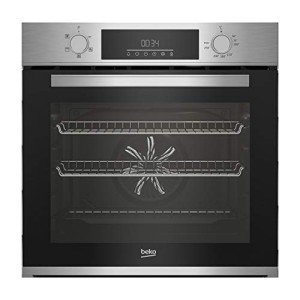You'll Be Unable To Guess Single Fan Oven's Secrets
페이지 정보
작성자 Kisha Hood 댓글 0건 조회 19회 작성일 25-06-28 08:34본문
Understanding Single Fan Ovens: A Comprehensive Guide
Intro
As modern-day kitchen areas grow progressively sophisticated, appliances developed for effectiveness and performance are at the leading edge of consumer interest. One such appliance that remains popular amongst home cooks and baking lovers is the single fan oven, an electric design understood for its versatility and ease of usage. This post provides thorough details about single fan ovens, including their performance, advantages, types, and factors to consider for purchase.
What is a Single Fan Oven?
A single fan oven, likewise referred to as a stove, includes a single cooking chamber with a fan and exhaust system that flows hot air uniformly throughout the cooking space. This results in an even cooking temperature and boosted cooking effectiveness compared to conventional fixed ovens.

Secret Components of a Single Fan Oven
- Heating Elements: Usually located at the leading and bottom, these create heat for cooking.
- Fan: The central feature that flows the hot air within the oven, promoting much faster and more even cooking.
- Thermostat: Regulates the temperature to ensure ideal cooking conditions.
- Control Panel: Provides interface alternatives for setting temperature levels, cooking times, and modes.
How Does a Single Fan Oven Work?
Single fan ovens run by combining the heat from the heating aspects with the air motion produced by the fan. The hot air is dispersed evenly around the food, significantly reducing cooking time while likewise enabling for lower cooking temperature levels.
Advantages of Using a Single Fan Oven
- Faster Cooking Times: The flowing air permits food to cook faster compared to standard ovens.
- Even Cooking: Food is exposed to constant heat from all sides, lowering the possibilities of unequal cooking or hot spots.
- Versatility: These ovens can be utilized for baking, roasting, and even grilling, making them ideal for a wide variety of recipes.
- Energy Efficiency: By cooking at lower temperature levels and in less time, these ovens might use less energy than their traditional equivalents.
- Wetness Retention: The design helps maintain wetness in dishes, resulting in juicy roasts and baked goods with a light texture.
Types of Single Fan Ovens
When thinking about a single fan oven, consumers might come across various types based upon functions and design. Here are a couple of common types:
1. Built-in Single Fan Ovens
- Description: Integrated into kitchen cabinets for a seamless appearance.
- Pros: Saves counter space, aesthetically pleasing.
- Cons: Higher setup expenses, might require professional aid.
2. Freestanding Single Fan Ovens
- Description: Standalone units that can be put throughout the kitchen.
- Pros: Easy to install, versatile placement.
- Cons: Can use up more area, might not mix well with cabinets.
3. Range Cookers with Fan Ovens
- Description: Multiple cooking alternatives, including a fan oven, combined in one unit.
- Pros: Offers numerous cooking approaches, perfect for enthusiastic cooks.
- Cons: Generally more costly, bigger footprint.
Contrast Table of Single Fan Oven Types
| Type | Pros | Cons |
|---|---|---|
| Built-in | Space-saving, aesthetically pleasing | Higher expenses, expert setup needed |
| Freestanding | Flexible placement | Takes up more space, might not match kitchen cabinetry |
| Range Cooker | Numerous cooking methods | Higher price, larger size |
Selecting the Right Single Fan Oven
When selecting a single fan oven, a number of factors must be considered to guarantee that it meets individual cooking needs and fits within your kitchen design.
Factors to Consider
- Size and Capacity: The size ought to match your kitchen design while providing adequate capacity for your cooking routines.
- Features and Functions: Look for adjustable racks, self-cleaning options, and multiple cooking modes to improve versatility.
- Energy Efficiency: Check for energy rankings; some models are created to be especially energy-efficient.
- Budget: Costs can differ significantly, making it important to develop a reasonable budget plan in advance.
Upkeep Tips for Single Fan Ovens
- Regular Cleaning: Wipe down interior surface areas after use to prevent residue build-up.
- Examine the Fan: Ensure the fan is devoid of obstructions and working correctly.
- Check Seals: Regularly examine the door seals for wear and tear to keep cooking performance.
- Professional Servicing: Schedule regular professional checks to guarantee optimum operation.
FAQs about Single Fan Ovens
1. Can I use my single fan oven for baking?
Absolutely! Single fan ovens are outstanding for baking, providing consistent temperature levels vital for cakes, cookies, and breads.
2. Is it needed to preheat a single fan oven?
While preheating is usually advised for optimal outcomes, due to the performance of a fan oven, some dishes may not need it.
3. Can I prepare numerous meals simultaneously?
Yes! The even heat distribution in single fan ovens enables you to bake or roast numerous dishes at the same time, making use of all rack levels successfully.
4. Does a single fan oven cook faster than a traditional oven?
Yes, the fan-assisted heating lowers cooking times, allowing faster food preparation.
Single fan ovens use a remarkable balance of speed, versatility, and efficiency, making them a valuable addition to any kitchen. Whether for baking, roasting, or everyday cooking, these ovens ensure that home cooks can produce scrumptious meals with ease. By comprehending the advantages, types, and considerations for acquiring a single fan oven, customers can make an informed decision that aligns with their cooking desires and kitchen characteristics.
Accepting the functionalities of a single fan oven unquestionably leads the way for boosted cooking experiences in the modern kitchen.
- 이전글비닉스 정력원.COM 온오프티비 25.06.28
- 다음글【광고문의:둘리알바】 안양노래방도우미알바 안산노래방도우미알바 부천노래방도우미알바 평택노래방도우미알바 25.06.28
댓글목록
등록된 댓글이 없습니다.

